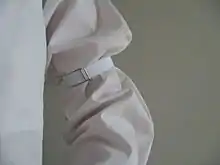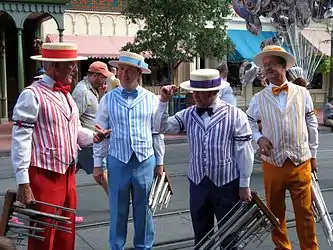Sleeve garter
A sleeve garter is a garter worn on the sleeve of a shirt. It came into wide use, especially in the USA, in the latter half of the 19th century when men's ready-made shirts came in a single (extra long) sleeve length. Sleeve garters allow men to customize sleeve lengths and keep their cuffs from becoming soiled while working or at the correct length when worn under a jacket.

Use
While a century ago this item of clothing was once something a man may have worn regardless of profession (with the possible exception of the wealthy or those too well-dressed to wear non-tailored shirts), today sleeve garters are usually seen in relation to one of the following contexts:
Music

According to jazz historian Al Rose,[1] the popular image of an early 20th-century saloon pianist being flashily dressed with arm garters was inspired by the way Tony Jackson used to dress while performing. Sleeve garters are still worn not only by pianists who play ragtime and other turn of the 20th century American music, but also by Dixieland banjo players and many other types of musicians who perform music of that general period. Because sleeve garters are very much a part of the costume of contemporary barbershop music performance, an activity for which unimpeded manual dexterity does not play a vital role, the association between sleeve garters and the contemporary performance of turn of the 20th century music may have more to do with evoking the fashion of the era than with utility or a tradition begun at some later time.
Gambling
Today, sleeve garters are part of the costume of poker dealers and other card dealers in casinos. While this is widely understood to make it more difficult for the dealer to cheat by concealing a card in his sleeve, note that the sleeve garter is usually accompanied by a vest and bow tie (and sometimes a visor) suggesting that this usage, too, might hark back to late 19th and early 20th centuries fashion at least as much as it serves a real purpose.[2]
Old West
The sleeve garter is often seen in modern depictions of the Old West, not only on musicians and gamblers but on the stereotypical well-dressed gunslinger. In this case, the suggestion may be that the sleeve garter facilitates freedom of movement and aids in gunslingers' ability to quick draw.[3]
Today, the sleeve garter sometimes accessorizes the costumes of rodeo participants. A small ornamental plate called a "concho", typically depicting an Old West motif, may be attached to the garter.[4]
Bookkeeping
"Day Dreaming Bookkeeper", Norman Rockwell's 1924 illustration, shows an accountant wearing a vest, a visor, a bowtie and very narrow sleeve garters. While the fellow is probably meant to be seen as old-fashioned in his dress, the presence of sleeve garters in this picture may indicate that men who worked with papers and ink sometimes wore sleeve garters up until the second quarter of the 20th century.[5]
Whether because of this or solely because of the iconic quality of Rockwell's work, office workers in early 20th century settings are sometimes depicted with this same costume (visor, vest, bow tie, sleeve garters) that is basically the same as the stereotypical card dealer costume.
"Old Timeyness"
Sleeve garters often appear in images representing "Old Timeyness" and can be seen in various pop culture depictions of it.
Homecoming
Sleeve garters (known as "mums") are commonly given to boys for homecoming by their dates in the Southwestern United States. The garters are then worn to the game and dance. These are usually very elaborate and consist of many ribbons and ornaments with a chrysanthemum in the center. The decorations are usually related to the wearer's interests and school.
Bartending
Occasionally sleeve garters will also appear in prohibition-era imagery and invokes the feeling of old speakeasies. Bartenders would and still occasionally do wear sleeve garters to keep their sleeves from falling down and getting wet while wiping down the bar. The garters also help to keep the hands from being encumbered while cleaning glassware. Sometimes sleeve garters are still worn in high-end bars to keep staff looking professional. If the mixologist is not required to wear a jacket, sleeve garters can be used as an alternative to rolling up shirt sleeves which may appear to be unprofessional.
See also
References
- Storyville, New Orleans: Being an Authentic, Illustrated Account of the Notorious Red Light District by Al Rose.
- A stereotypical poker dealer Archived 2007-09-29 at the Wayback Machine image.
- A stereotypical Old West cardsharp/gunslinger image.
- sleeve garters as rodeo costume Archived 2011-07-07 at Archive.today
- Day Dreaming Bookkeeper Archived September 28, 2007, at the Wayback Machine, 1924, by Norman Rockwell.